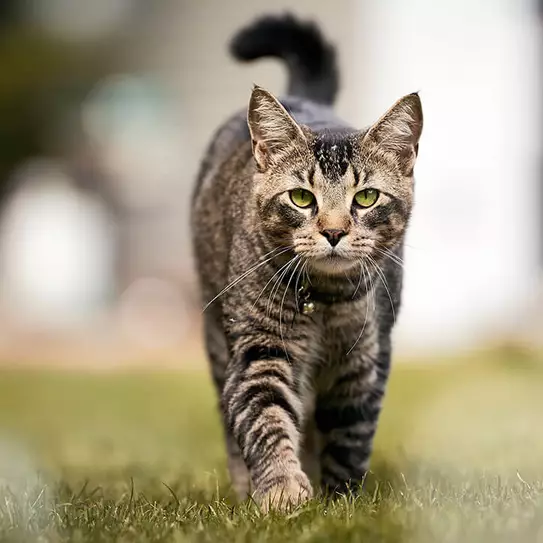Cat owners should always be aware that their pet may have illnesses that it does not show. Cats are masters at hiding pain. Only those who really know their cat can notice that it might be ill by looking at changes in its nature or behaviour. For example, if it stops going to its high perch or can't get up in one bound, this could be a sign of pain in the joints. An unkempt coat could also be a sign - if the cat
can no longer lick all parts of its body without pain.
Dog owners regularly take their pets for walks and thus enable them to exercise, ideally also in off-leash play with other dogs of the same species. This physical exercise is important for a healthy musculoskeletal system, along with the right diet. The situation is different with cats. If you only keep your pet indoors, you are responsible for the right balance between exercise and nutrition. If your cat
is not active on its own, you should encourage it to move by playing and climbing. In this way, you give her body the opportunity to form the protective synovial fluid itself.
It's a different story with free-rangers: Here we can assume that they get sufficient and species-appropriate exercise. But here, too, please keep an eye on the weight of the animal to avoid joint problems due to overweight.
Unfortunately, your cat's arthrosis cannot be cured. But you can contribute to your cat having a good quality of life into old age through your attention and a healthy diet.
Symptoms
Because cats often do not show us their limitations due to pain, you as an owner should be sensitive to changes and arrange a check-up with the vet if your cat shows a new behaviour:
- She moves less, more stiffly, no longer jumps on her favourite high place.
- She gains weight because she moves less because of the pain.
- She loses weight because she rarely goes to the food bowl because of the pain.
- She grooms her coat less because the movements cause her pain.
- She has no desire to play and be touched.
- She sleeps more.
- Maybe she becomes more aggressive, more fearful or changes her behaviour in a different way that you are not used to from her.
Many of these symptoms can also have other causes. Your vet will find out what exactly is wrong with your cat.
Not only older cats can be affected by these symptoms, so they cannot be attributed solely to increasing age. They can also occur without a pre-existing condition and can, for example, be favoured by joint malformations in young cats. However, these indications lead to the suspicion that the animal may be suffering from arthrosis as a chronic degenerative joint disease. Osteoarthritis most commonly affects the elbow, shoulder, hip and knee. However, it can also occur in the spine and lower limb joints.

The course of arthrosis
Osteoarthritis usually begins with cartilage damage caused by excessive stress or injury to the joints. The inflamed synovial membrane then swells and forms more synovia, the synovial fluid. This is actually viscous, but in acute cases it is unfortunately thin and thus inferior. Thus it does not form a resilient protective film for the cartilage. This leads to inflammation in the joint, which in turn can cause further tissue damage. A cycle of cartilage degradation and inflammation develops.
The animals spare the affected joint in order to avoid pain. This resting posture also aggravates the arthrosis, because the remaining joint cartilage is less well nourished by less movement. Unfortunately, it is a vicious circle that must be interrupted by therapeutic measures.
Treatment of osteoarthritis
Once osteoarthritis has been diagnosed in your cat, the veterinarian has the option of influencing the disease through conservative therapy methods. Through pain therapy, acupuncture, chiropractic or physiotherapy, he will try to achieve success in relieving pain and restoring mobility.
Supplementing important active ingredients by giving dietetic complementary feed is also an option that the veterinarian will consider before surgery.
If your cat suffers from osteoarthritis of the hip joint (which is the most common), in advanced cases the vet can remove the affected joint head and smooth out the bone areas so that a pseudo joint can form from scar tissue and muscle fibres. The insertion of an artificial hip joint is also a possible option.
In some parts of the body, joint fusion may be considered as the last step after a series of conservative measures. It gives the cat freedom from pain, but at the same time restricts its movements. This drastic procedure will only be considered by cat owners whose cat is in great pain Any surgical intervention should be a last resort in the treatment of arthritis, when all other treatment options have been exhausted.
In the case of osteoarthritis, it is advisable to feed special supplementary feeds with joint-active, high-dose ingredients such as omega-3 fatty acids, vitamin E, green-lipped mussel, rosehip, glucosamine and chrondroitin. These nutrients can also be given preventively to support joint health.